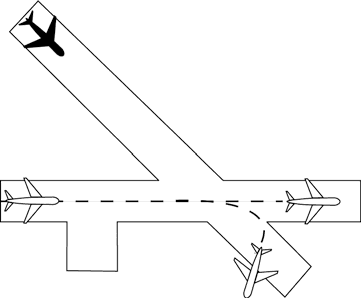3-9-8. INTERSECTING RUNWAY/INTERSECTING FLIGHT PATH OPERATIONS
- Views Views: 1,774
- Last updated Last updated:
-
3-9-8. INTERSECTING RUNWAY/INTERSECTING FLIGHT PATH OPERATIONS
- Issue traffic information to each aircraft operating on intersecting runways.
- Separate departing aircraft from another aircraft using an intersecting runway by ensuring that the departure does not begin takeoff roll until one of the following exists:
- The preceding aircraft has departed and passed the intersection or is turning to avert any conflict. (See FIG 3-9-9).
FIG 3-9-9 Intersecting Runway Separation 
- A preceding arriving aircraft (See FIG 3-9-10)
- (a) Is clear of the landing runway, or
- (b) Has completed the landing roll on the runway and will hold short of the intersection, or
- (c) Has completed the landing roll and is observed turning at an exit point prior to the intersection, or
- (d) Has passed the intersection.
FIG 3-9-10 Intersecting Runway Separation 
WAKE TURBULENCE APPLICATION
- Separate aircraft taking off behind a departing or landing aircraft on an intersecting runway if flight paths will cross (See FIG 3-9-11 and FIG 3-9-12):
NOTE: Takeoff clearance to the following aircraft should not be issued until the appropriate time interval has passed after the preceding aircraft began takeoff roll.
- (a) Heavy, large, or small behind super - 3 minutes.
- (b) Heavy, large, or small behind heavy - 2 minutes.
- (c) Small behind B757 - 2 minutes.
FIG 3-9-11 Departure Behind Departure on Intersecting Runway 
FIG 3-9-12 Departure Behind Arrival on Intersecting Runway 
- Pilot requests to deviate from the required time intervals must not be approved if the preceding aircraft requires wake turbulence separation.
- The preceding aircraft has departed and passed the intersection or is turning to avert any conflict. (See FIG 3-9-9).